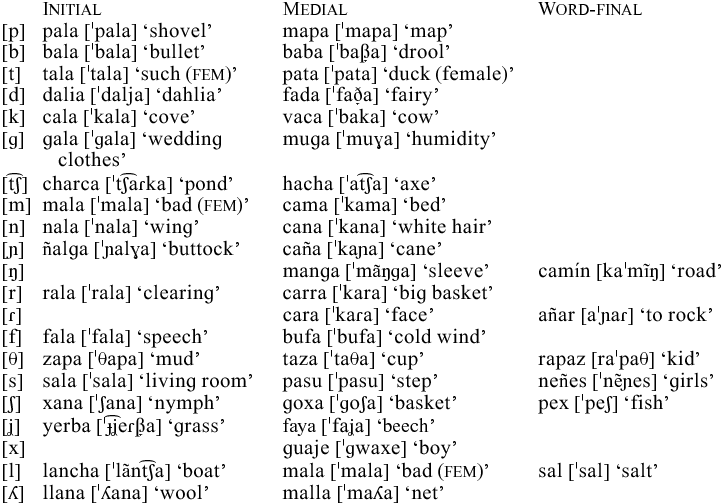Asturian (ISO 639), also known as Bable, Asturiano, Asturianu, Astur-Leonese or Leonese, is the vernacular language of Principality of Asturias, an autonomous community of just over one million inhabitants located in Northern Spain. Asturian is spoken by approximately 100,000 individuals within Asturias plus a few thousand more outside of this region. Historically, Astur-Leonese was spoken in parts of the Spanish provinces of León and Zamora and there are still remnants of it in Castilian Spanish. In addition, a variety of Asturian – called Mirandés – is currently spoken in the Portuguese province of Miranda de Douro, where it is a language co-official with Portuguese (Figure 1).
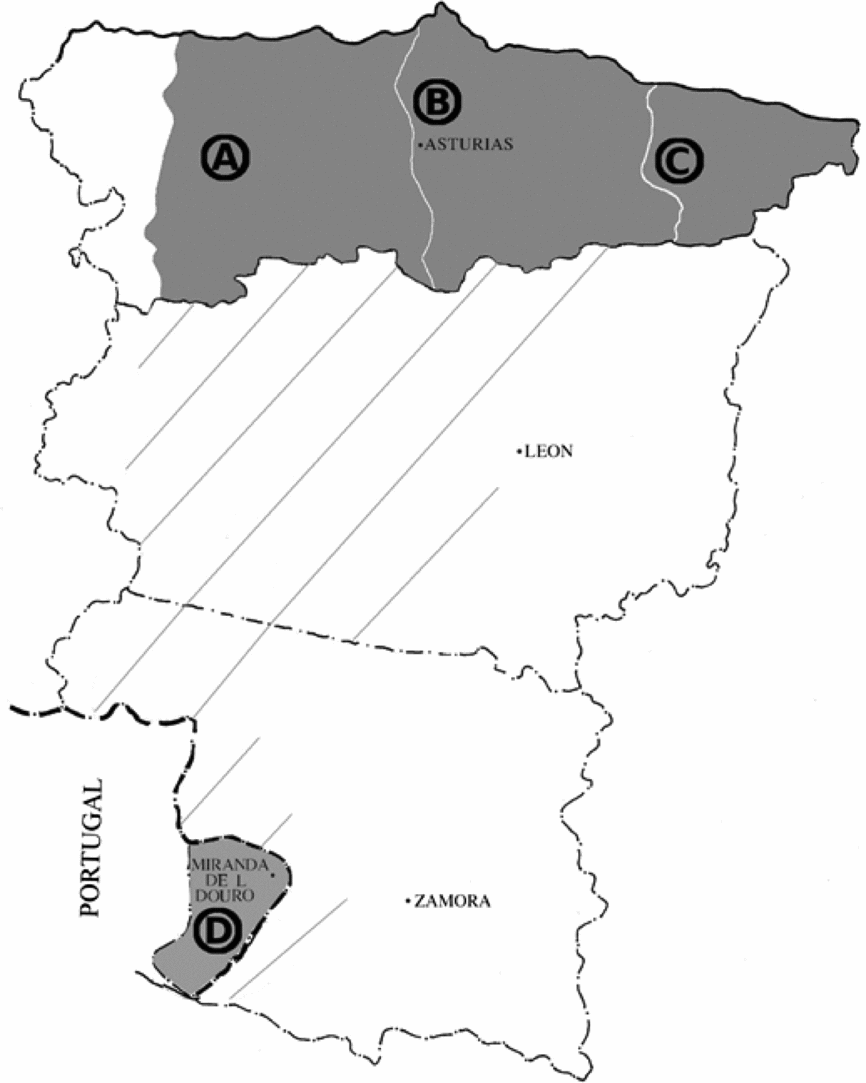
Figure 1 Map of the Asturian language. A: Western Asturian, B: Central Asturian, C: Eastern Asturian, D: Mirandés.
Asturian is an Indo-European, Romance language of the West Iberian branch. The most prominent dialects correspond to geographical criteria and are: Central Asturian, spoken by about 50,000 speakers, Eastern Asturian, with about 20,000 speakers, and Western Asturian, spoken by roughly 30,000 speakers. The language variety described here is Central Asturian, which is considered the most representative and has been the base of the vocal and consonant standard (Llera-Ramo & Sanmartín-Antuña Reference Llera-Ramo and Sanmartín-Antuña2002).
Since 1980, the Academia de la Llingua Asturiana has been responsible for the linguistic standardization, maintenance and dissemination of the Asturian language and its literature. However, although it can be studied in schools, Asturian coexists with Castilian Spanish in an unequal degree of use, mainly due to not having been recognized as an official language of the Principality of Asturias (Academia de la Llingua Asturiana 2002).
Consonants
Asturian consonants include a series of voiceless stops /p t k/ with their corresponding voiced sounds /b d ɡ/. The consonants /t d/ are dental. The sounds /b d ɡ/ are pronounced as stops when in the absolute word-initial position or after a nasal consonant. /d/ is also pronounced as a stop when preceded by /l/. In the rest of the cases, they are pronounced as approximants [
] (Academia de la Llingua Asturiana 1998: 36–43). Particular attention should be given to the pronunciation of the /ɡ/ because in Asturian it encompasses a wide range from the stop [ɡ] to the uvular fricative [ʁ], passing through approximant [
]. This variation may be due to the fact that, by contrast to Spanish, voiceless velar friction was absent in Asturian and there was no opposition with other approximant or fricative sounds articulated in the velar or post-velar area. Given the ample margin for pronunciation without confusion with other sounds and an imprecise pronunciation characteristic of the velar, voiced, or even voiceless sounds, uvular fricative pronunciations are frequently encountered (Muñiz-Cachón Reference Muñiz-Cachón2002).
Nasal phonemes in the syllable coda assimilate to the place of articulation of the following consonant making it easy to find dental, palatalized or velarized nasals by coarticulation effect. In addition, at the end of the word, it is very frequent to pronounce the [ŋ] velar when it is preceded by any vowel, e.g. camín [kaˈmĩŋ] ‘road’ (Muñiz-Cachón Reference Muñiz-Cachón2003).
It should be noted that, among the fricative consonants, the Asturian /s/, as in northern peninsular Castilian Spanish, has an apico-alveolar pronunciation [![]() ] and on many occasions the Asturian realization is a more retracted [s], although different from the post-alveolar one [ʃ].
] and on many occasions the Asturian realization is a more retracted [s], although different from the post-alveolar one [ʃ].
In the syllable coda, the fricatives /θ/ and /s/ tend to become voiced when in contact with a voiced consonant and tend to assimilate their point of articulation to that of the adjacent consonant when the adjacent consonant is dental. The rest of the voiceless fricatives rarely appear in the syllable coda and, when they do, are more impervious to becoming voiced when in contact with voiced consonants.
A recent addition to Asturian is a voiceless dorsal fricative, the place of articulation of which is between that of the velar [x] and the uvular [χ]; here it is transcribed as velar [x]. Though it is currently used in very few words, it is becoming increasingly more common due to the influence of Castilian Spanish (García-Arias Reference García-Arias2003: 29).
The voiced palatal fricative /ʝ/ normally has two pronunciations. It is pronounced as an affricate [![]() ] when in the absolute initial position and when in the middle of the word if preceded by a nasal consonant or /l/. In all other positions, it is pronounced as [ʝ] – a voiced palatal fricative.
] when in the absolute initial position and when in the middle of the word if preceded by a nasal consonant or /l/. In all other positions, it is pronounced as [ʝ] – a voiced palatal fricative.
Finally, in Asturian, as in Castilian Spanish, there is a marked tendency – called yeismu – to pronounce the voiced palatal lateral [ʎ] as a voiced palatal fricative [ʝ], e.g. calla [ˈkaʝa] ‘nappy’ (García-Arias Reference García-Arias2003: 37).
Differences between dialects
One of the most frequent dialectal features for consonant sounds with a common Latin origin is the different realization between the standard /ʎ/ and the varieties of southwestern Asturian called che vaqueira. These tend to be a voiceless or voiced retroflex affricate ([ʈʂ] and [ɖʐ], respectively).
Moreover, it is important to note the pronunciation of the voiceless labiodental fricative /f/ as a voiceless glottal fricative consonant [h], or even as a voiceless velar fricative [x], as a characteristic trait of eastern Asturian. Mangold (Reference Mangold1955: 32–33) confirms this trait in the transcribed passage published in Le Maître Phonétique, entitled ‘El vientu norte y el sol’, in the word h.uercia [ˈxweɾθja] ‘strength’, which is fuercia [ˈfweɾθja] in Standard Asturian.
Vowels
The Asturian phonological system consists of five vowels, /a e i o u/, used in both stressed and unstressed syllables. The vowels involve three degrees of tongue height – high, /i u/; mid, /e o/; and low, /a/ – and three degrees of backness – front, /i e/; central, /a/; and back, /o u/ (Figure 2).
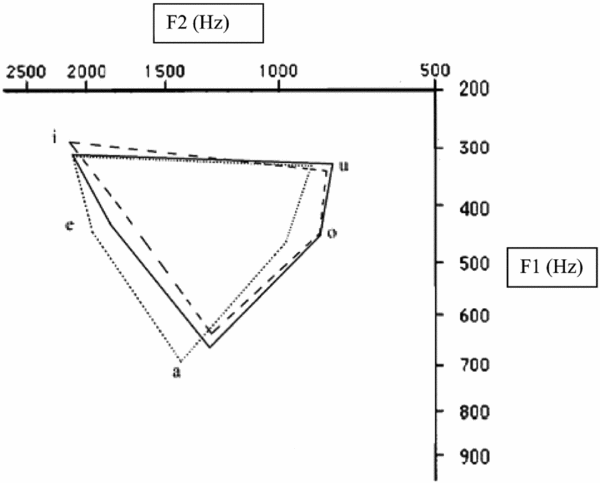
Figure 2 Stressed vowels (—), unstressed vowels (— —), and unstressed final vowels (· · · ·).
This variation of the final vowels occurs in Asturian in a meaningful way since the vowels /a o u/ represent morphological gender values in the adjectives. The vowels at the end of the word make the difference between feminine singular [-a] – e.g. la neña ye mala [ˈmala] ‘the girl is bad (fem, adj)’, masculine singular [-u] – el neñu ye malu [ˈmalu] ‘the child is bad (masc, adj)’, and mass nouns [-o] – la xente ye malo [ˈmalo] ‘people are bad (with mass nouns)’.
As in Castilian Spanish, there is a notable difference in the degree of opening of the vowels depending on the context. However, this difference is neither systematic nor constant and in no case does it serve to differentiate meaning.
On the other hand, an phonetic phenomenon that does seem quite systematic, though with no phonological implications, is the nasalization of vowels due to coarticulation when they appear between nasal consonants, e.g. neñes [ˈnẽɲes] ‘girls’, or are followed by a nasal in syllable coda, e.g. lancha [ˈlãnt![]() a] ‘boat’.
a] ‘boat’.
Two peculiarities of Asturian should be noted when comparing it with similar languages, such as Castilian Spanish. On one hand, the difference between the back vowels /o u/ depends more on the tongue height than backness. In the values reported in Castilian Spanish (Martínez Celdrán Reference Martínez-Celdrán1995: 201–203; Martínez-Celdrán, Fernández-Planas & Carrera-Sabaté Reference Martínez-Celdrán, Fernández-Planas and Carrera-Sabaté2003: 256) for stressed vowels in male speech, the F2 of the [o] is 1070 Hz, while in Asturian the F2 of the [o] is 850 Hz. This indicates that the Asturian [o] has a further back realization than the Castilian Spanish [o], close to the Asturian [u], which has an F2 average value of 800 Hz. However, the F1 distance – with an average mean frequency of 453 Hz for the stressed [o] and 318 Hz for the stressed [u] – serves in Asturian as a base for vowel differentiation. On the other hand, as mentioned above, the opposition between unstressed vowels at the end of the word plays a role in the morphological differentiation. Therefore, the F1 in final unstressed series illustrated above is similar to the F1 in the stressed series for both [o] and [u], while the F2 of the unstressed final [o] – 977 Hz – is higher than the stressed one – 850 Hz (see Figure 2). Figure 2 contains average values of the vowel formants from the recordings of seven middle-aged male adults from central Asturias. Analysis was performed on 15 recorded words listed at the start of the present section.
Dialectal differences
In some areas where Central Asturian is spoken, there is a certain instability in the timbre of the stressed vowels due to the metaphonic influence exerted by the high vowel /u/ in the final, unstressed position. This metaphony consists in the raising of the stressed vowels /e/ > /i/ e.g. pelu [ˈpelu] > pilu [ˈpilu] ‘hair’ and /o/ > /u/ e.g. tontu [ˈtõntu] > tuntu [ˈtũntu] ‘silly’. This raising of the stressed vowel also affects the /a/, although in a different way depending on the region. Thus, in the Caudal river basin and in Cabu Peñes, /a/ is raised and fronted /a/ > /e/, e.g. platu [ˈplatu] > pletu [ˈpletu] ‘dish’. In the Nalón river basin /a/ is raised and retracted /a/ > /o/, e.g. platu [ˈplatu] > plotu [ˈplotu] ‘dish’. However, this metaphonic raising does not reduce the vowel oppositions since the five-member vowel system is maintained when the word does not end in a high vowel. This can be seen in the following examples: pilu [ˈpilu] ‘hair’ ~ pelos [ˈpelos] ‘hairs’, tuntu [ˈtũntu] ‘silly’ ~ tontos [ˈtõntos] ‘silly (pl)’, pletu [ˈpletu]/plotu [ˈplotu] ‘dish’ ~ [ˈplatos] ‘dishes’. This process of metaphony is present in the areas mentioned above. It coexists with the standard pronunciation, in which this type of vocalic metaphony does not occur, and produces certain instability and alternation in the vowel timbre (García-Arias Reference García-Arias2003: 13–14; Hualde Reference Hualde2005: 131–134).
On the other hand, in Western Asturian the opposition /e/ ~ /i/ and /o/ ~ /u/ disappears in the unstressed vowel endings. In contrast to what occurs in Central and Eastern Asturian, which maintains the five vowels shown above, in Western Asturias the final unstressed vowel system is reduced to three units: /a/, /i/, pronounced as either [e] or as [i], and /u/, pronounced as either [o] or as [u] (García-Arias Reference García-Arias2003: 19).
Diphthongs and triphthongs
When unstressed, the high vowels /i/ and /u/ become glides, i.e. non-syllabic vowels, and they form diphthongs and triphthongs with adjacent vowels. In Asturian there are two types of diphthongs: rising diphthongs, formed by a glide plus a vowel, and falling diphthongs, formed by a vowel plus a glide. Tradition distinguishes the symbol [j]/[w] in the prenuclear position versus [![]() ]/[
]/[![]() ] in the post-nuclear syllable margin to indicate that, in both cases, [j]/[w] and [
] in the post-nuclear syllable margin to indicate that, in both cases, [j]/[w] and [![]() ]/[
]/[![]() ] represent non-syllabic vowels. Diphthongs can occur in both stressed or the unstressed syllables.
] represent non-syllabic vowels. Diphthongs can occur in both stressed or the unstressed syllables.
In the following examples, the list on the left shows the falling diphthongs –formed by a low or medium vowel followed by a high vowel – and the list on the right shows the raising diphthongs – formed by a high vowel followed by a medium or low vowel:
When the two adjacent vowels are high, the diphthong can be rising or falling. In the above examples, the realizations of mui ‘very’ and fiu ‘son’ are both falling diphthongs.
It is also possible to find triphthongs: the nucleus is formed by one of the non-high vowels /e/, /o/, /a/; the preceding and following elements are always glides [j]/[w], and [
]/[
] depending on position. The following are examples of triphthongs with the nucleus [e]:
Prosody
Lexical stress
In Asturian, the stress does not always appear on the same syllable in words with the same structure. There are three stress patterns: words with the lexical stress on the last syllable (oxytone), the penultimate syllable (paroxytone) and the antepenultimate syllable (proparoxytone). Though scarce, there also are words with enclitic parts that can have the stress on the syllable before the antepenultimate one, e.g. déxanoslo [ˈdeʃanozlo] ‘lend it to us’. The syllable nucleus is always a vowel. The stress opposition has a contrastive function and is very productive since it differentiates the meaning between lexical sets, e.g. llima [ˈʎima] ‘lime’ ~ llimá [ʎiˈma] ‘slug’, and also between morphological forms, e.g. atopo [aˈtopo] ‘I find’ ~ atopó [atoˈpo] ‘s/he found’.
Phonetically, the stress is manifested in a pitch prominence. This is generally accompanied by a greater duration, and sometimes by a greater intensity of the stressed syllable. In isolated words, the highest pitch occurs on the stressed vowel itself, whereas in a sentence where the word is not in nuclear position, the pitch prominence is moved forward to the post-tonic vowel. However, syntactic boundaries – particularly the strong ones, e.g. between subject and predicate – sometimes slow down the displacement of the peak to the post-tonic vowel in oxytone words. In this case the pitch prominence is aligned with the lexically stressed syllable. In any case, the stressed syllable is the anchor point for the tonal events.
Rhythm
Asturian is a syllable-timed language, i.e. rhythmic intervals are marked by syllables and not by stresses, as is the case in stress-timed languages. Experimental studies (Muñiz-Cachón et al. Reference Muñiz-Cachón, Díaz-Gómez, Alvarellos-Pedrero and González-Rodríguez2010: 288–297) have confirmed this aspect of Asturian, since the greater duration of tonic vowels does not imply the reduction of unstressed vowels, which keep their stability and duration. This stability in the duration of the unstressed vowels in the syllable-timed languages produces a rhythmic effect different from the stress-timed languages (Hualde Reference Hualde2005: 273).
Intonation
Asturian is an intonational language. Stress serves as an anchoring point for intonational events. However, sometimes there is a certain deaccentuation process, associated with a maintenance of high pitch, without inflection on the stressed syllables.
As seen in Figure 3, the pattern of the Asturian pitch contour in the neutral declarative mode with three pitch accents (Muñiz-Cachón et al. Reference Muñiz-Cachón, Díaz-Gómez, Alvarellos-Pedrero and González-Rodríguez2010Footnote 2) starts at a low pitch and rises up to the post-tonic syllable of the first stressed word, which is associated with the highest peak of the statement. Then there is a valley followed by an upward movement to the second peak accent, always lower than the first. Finally, in the stressed syllable of the word carrying the nuclear accent, the curve descends to reach the lowest pitch of the statement. In doing so, the curve follows a stepwise decline (downstep).
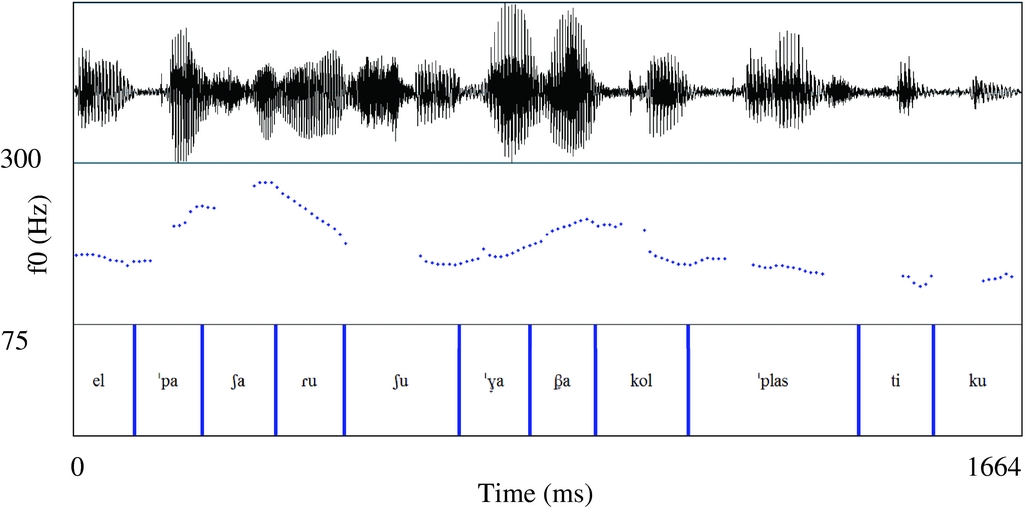
Figure 3 Declarative sentence: El páxaru xugaba col plásticu [el ˈpaʃaɾu ʃuˈ![]() a
a![]() a kol ˈplastiku] ‘The bird was playing with the plastic’.
a kol ˈplastiku] ‘The bird was playing with the plastic’.
Intonation is decisive in differentiating declarative sentences (statements) and yes/no interrogative sentences (polar or yes/no questions) because both may not differ at all in their syntax. The pitch contour of yes/no questions with three pitch accents starts at a low pitch, it rises-up to the post-tonic syllable of the first stressed word, where it maintains a high pitch with a small inflection around the second stress, and culminates in a downward trend starting its decline after the nuclear accent (see Figure 4).

Figure 4 Polar question (Central Asturian): ¿El rapacín xugaba col páxaru? [el rapaˈθĩn ʃuˈ![]() a
a![]() a kol ˈpaʃaɾu] ‘Did the child play with the bird?
a kol ˈpaʃaɾu] ‘Did the child play with the bird?
Differences between dialects
The pitch contour of declarative sentences is similar throughout the Asturian geography. However, this does not occur with yes/no questions, which present notable dialect variations resulting in three characteristic patterns in the geographic variants (Muñiz-Cachón et al. Reference Muñiz-Cachón, Díaz-Gómez, Alvarellos-Pedrero and González-Rodríguez2010, Alvarellos-Pedrero et al. Reference Alvarellos-Pedrero, Muñiz-Cachón, Díaz-Gómez and González-Rodríguez2011).
In Western and Central Asturian, the tune in polar questions is similar to that which was previously described with a greater tendency for deaccentuation and delay of the declination in the pre-nuclear accents, which culminates in a sharp descent after the nuclear accent (Figure 4).
The second interrogative pattern in yes/no questions, characteristic of the south-central area of Asturias, follows a trajectory similar to those of the neutral declarative statements, that is to say, it has two peaks with a stepwise descent (see Figure 5). However, these interrogatives differ from the declarative statements in that the interrogatives have a greater tonal range and a significant increase in the vowel's duration of the nuclear accent and in the last syllable.
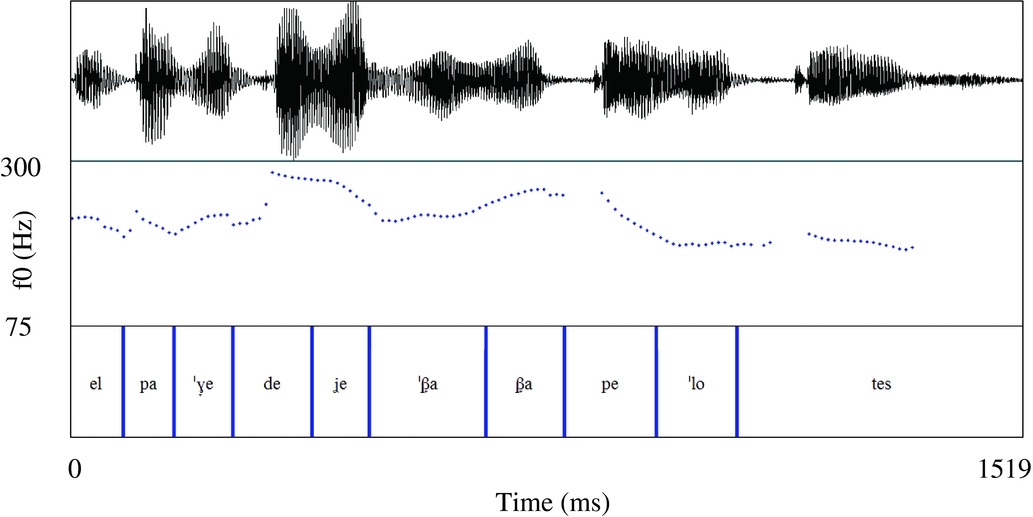
Figure 5 Polar question (South-central Asturian): ¿El paquete llevaba pelotes? [el paˈ![]() ede ʝeˈ
ede ʝeˈ![]() a
a![]() a peˈlotes] ‘Did the package carry balls?’
a peˈlotes] ‘Did the package carry balls?’
Finally, the third interrogative pattern belongs to the Eastern Asturian variant (Figure 6). Here, the pitch rises in the first accent, then a suspension is made which ends with a circumflex movement in the nuclear accent.
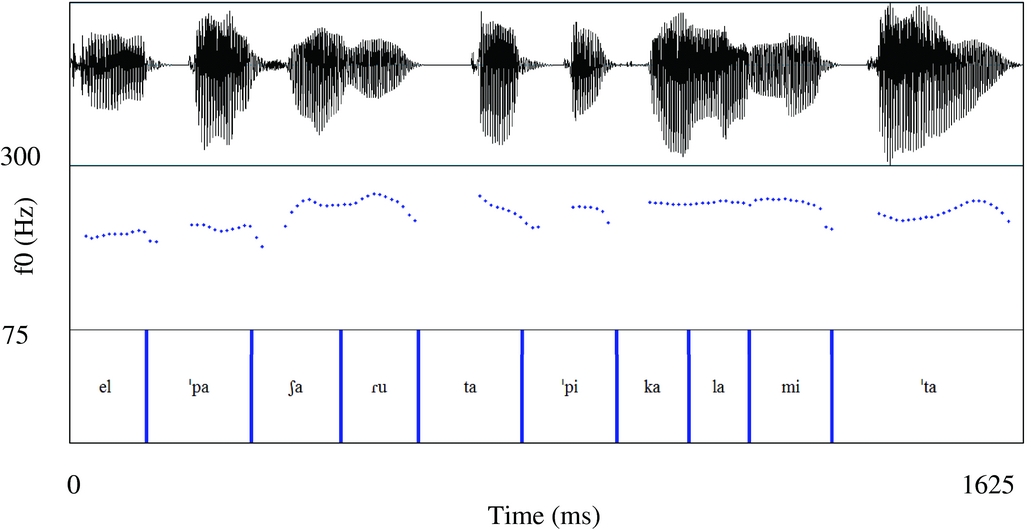
Figure 6 Polar question (Eastern Asturian): ¿El páxaru tapica la mitá? [el ˈpaʃaɾu taˈpika la mitá] ‘Does the bird peck at half (of something)?
Transcription of the recorded passage
Orthographic version
L'aire'l norte y el sol andaben a la tema por ver quién d'ellos tenía más puxu. Entós pasó per ellí un viaxeru envueltu nuna capa percalentina y pautaron que quien primero llograre que'l viaxeru quitare la capa tendríenlu por más poderosu. L'aire'l norte bufó enfurecíu pero cuanto más bufaba, más s'arrebollicaba'l viaxeru na so capa. A lo cabero, l'aire'l norte abandonó la xera. Entós perrellumó’l sol y, darréu, desenguedeyóse de la so capa'l viaxeru. Asina pescanció l'aire'l norte que'l sol yera'l más fuerte.
Transcription
Transcription in the Llanes dialect (Eastern Asturian) by Mangold (Reference Mangold1955)
[arˈmose uŋ xoˈɟiŋ entre ɛl ˈβjentu ˈnorte i ɛl ˈsol pa ˈβɛr ˈkwal de ˈeɟos teˈnia ˈmas ˈxwɛrθja. de ˈprontu aθɛrˈto a paˈsar u![]() paiˈsanu ˈtou arreβuˈsjau en una kaˈpona. apɔsˈtaron eŋ ke kje
paiˈsanu ˈtou arreβuˈsjau en una kaˈpona. apɔsˈtaron eŋ ke kje![]() ˈfwera ɛl priˈmeru ke oβliˈɣara al paiˈsanu a kiˈtase la ˈkapa seˈria teˈniu pɔl ˈmaz ˈβraβu. ɛl ˈβjentu ˈnɔrte soˈplo a ˈtoa ˈmartʃa. ˈperu ˈkwantu ˈmas sopˈlaβa, ˈmas se arreβuˈsjaβa aˈkɛl paiˈsanu. pɔr ˈfiŋ ɛl ˈβjentu ˈnɔrte ˈðjose pɔl pɛrˈðiu. enˈtonθez βriˈɟo ɛl ˈsɔl kɔn ˈtoa ˈfurja i al moˈmentu kiˈtose la ˈsu ˈkapa el paiˈsanu po lo ˈkwal ˈnoi keˈðo ˈɔtru rrɛˈmeðju al ˈβjentu ˈnɔrte ke rrekonoˈθɛr la ˈxwɛrθja ðɛl ˈsɔl]
ˈfwera ɛl priˈmeru ke oβliˈɣara al paiˈsanu a kiˈtase la ˈkapa seˈria teˈniu pɔl ˈmaz ˈβraβu. ɛl ˈβjentu ˈnɔrte soˈplo a ˈtoa ˈmartʃa. ˈperu ˈkwantu ˈmas sopˈlaβa, ˈmas se arreβuˈsjaβa aˈkɛl paiˈsanu. pɔr ˈfiŋ ɛl ˈβjentu ˈnɔrte ˈðjose pɔl pɛrˈðiu. enˈtonθez βriˈɟo ɛl ˈsɔl kɔn ˈtoa ˈfurja i al moˈmentu kiˈtose la ˈsu ˈkapa el paiˈsanu po lo ˈkwal ˈnoi keˈðo ˈɔtru rrɛˈmeðju al ˈβjentu ˈnɔrte ke rrekonoˈθɛr la ˈxwɛrθja ðɛl ˈsɔl]
Acknowledgements
I am grateful to two referees for their very helpful comments. I would like to thank also Ewa Jaworska and Amalia Arvaniti for their many helpful suggestions.




